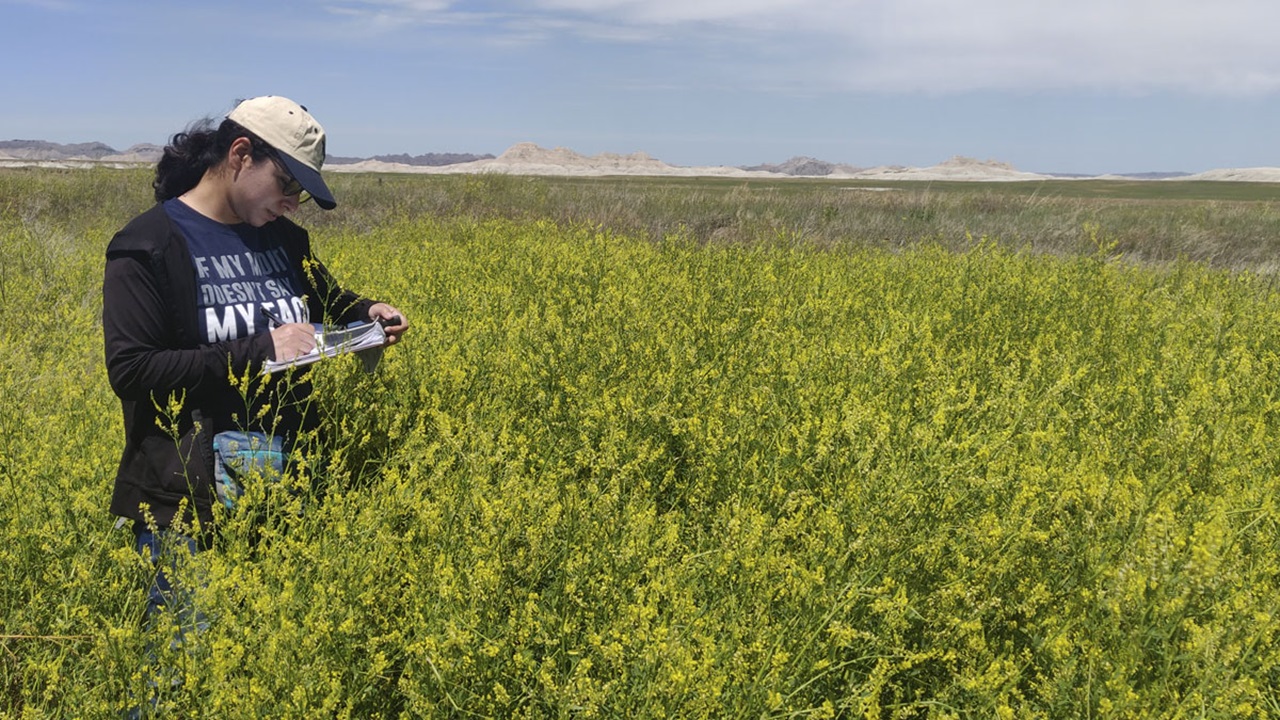USD Receives NSF Grant to Study Invasive Plant in South Dakota
The University of South Dakota recently received a $100,000 grant from the National Science Foundation to help manage the spread of an invasive plant across Western South Dakota using machine learning.

Sakshi Saraf studying yellow sweet clover in Buffalo Gap National Grasslands in the summer of 2022. Photo credit: Venkatesh Kolluru
The invasive plant – yellow sweet clover (YSC) – is an annual legume forb, planted initially for bee habitat and soil erosion management. However, there has been a dramatic increase of YSC with super blooms in South Dakota, following higher precipitation in 2019. YSC can provide a habitat and nectar for honeybees, but it can also poison and cause hemorrhaging in livestock when it’s used as a hay component.
Leading the project is Ranjeet John, Ph.D., assistant professor in the Departments of Biology and Sustainability. Sakshi Saraf, a Ph.D. biology student, and Reza Golijani-Amirkhiz, a biology postdoc, will assist John.
The team will collaborate with scientists from the USGS Earth Resources Observation and Science Center (EROS) out of Sioux Falls to develop machine learning predictive models using high-performance computing (HPC).
Through USD’s supercomputer, they will create high-resolution species distribution maps to inform land managers and policy makers to help manage the spread of YSC across South Dakota and the Northern Great Plains.
"As a frontier invasive, YSC facilitates the establishment of other invasive plant species through substantial nitrogen fixing and accumulation ability (84 kg N per hectare),” said John. “YSC has the potential to cause ecosystem-level changes in the Northern Great Plains, which are low-nitrogen systems.”
John’s work can also serve as a protype to map other invasive plant species and find new opportunities and innovations to monitor rangeland vegetation.
Students can also learn about these research methods and applications in two courses – Remote Sensing and Drone Applications – developed for the USD geospatial course certificate.
Leading the project is Ranjeet John, Ph.D., assistant professor in the Departments of Biology and Sustainability. Sakshi Saraf, a Ph.D. biology student, and Reza Golijani-Amirkhiz, a biology postdoc, will assist John.
The team will collaborate with scientists from the USGS Earth Resources Observation and Science Center (EROS) out of Sioux Falls to develop machine learning predictive models using high-performance computing (HPC).
Through USD’s supercomputer, they will create high-resolution species distribution maps to inform land managers and policy makers to help manage the spread of YSC across South Dakota and the Northern Great Plains.
"As a frontier invasive, YSC facilitates the establishment of other invasive plant species through substantial nitrogen fixing and accumulation ability (84 kg N per hectare),” said John. “YSC has the potential to cause ecosystem-level changes in the Northern Great Plains, which are low-nitrogen systems.”
John’s work can also serve as a protype to map other invasive plant species and find new opportunities and innovations to monitor rangeland vegetation.
Students can also learn about these research methods and applications in two courses – Remote Sensing and Drone Applications – developed for the USD geospatial course certificate.
